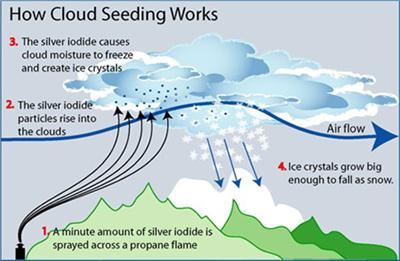As the specter of climate change looms larger on our horizon, the quest for innovative solutions to mitigate its effects intensifies. Among these, cloud seeding emerges as a tantalizing possibility. Are we merely embarking on a quest for weather control, or does this practice represent a genuine method to combat the escalating challenges of climate change? This inquiry beckons us to explore the intricate mechanics of cloud seeding, its implications for our climate, and the myths that enshroud this controversial technique.
To understand the conversation around cloud seeding, one must first grasp what the process entails. Cloud seeding involves the introduction of substances—such as silver iodide, salt, or even dry ice—into the atmosphere to stimulate precipitation from clouds. This manipulation aims primarily to enhance rainfall, alleviate drought conditions, or even disperse fog. Practitioners of this technique assert that it serves as a tool for managing water resources, particularly in arid regions struggling with the adversities of climate change.
However, as we delve deeper, the implications of cloud seeding beg the question: is this method a means of weather control or just a mirage? Advocates claim that cloud seeding can augment precipitation by as much as 30%. If true, such an increase could provide water to drought-stricken areas, offering some relief in our increasingly erratic weather patterns. Yet, skeptics flatly challenge these assertions. Are the claimed benefits a mere rehash of scientific optimism, or is there a substantive basis for these assertions? The veracity of these claims hinges on rigorous scientific evaluation.
An equally pertinent matter is the ecological impact of cloud seeding. Utilizing substances like silver iodide raises several alarm bells regarding potential contamination of ecosystems. Critics argue that the long-term environmental consequences remain shrouded in uncertainty. Given that silver is toxic in nature, its introduction into the environment could disrupt local flora and fauna. The potential for bioaccumulation also prompts concern about diminishing biodiversity. Thus, one must carefully weigh the purported benefits of cloud seeding against the risk of inadvertently exacerbating other environmental challenges.
Additionally, a pivotal question arises regarding the efficacy of cloud seeding concerning climate change. While it may bolster localized precipitation, does it truly address the broader issues of global warming? Some researchers posit that this technique might simply redistribute existing water rather than create new sources. Such a view perpetuates the cycle of inequity by favoring specific regions over others. If cloud-seeding efforts result in increased rainfall for one area, it could mean diminished water availability for neighboring regions. This geographical inequality raises ethical considerations about the implementation of such technologies.
Furthermore, cloud seeding sits at the intersection of technological intervention and nature’s inherent systems. Some experts posit that while cloud seeding might offer short-term solutions, it fails to confront the root causes of climate change—namely, greenhouse gas emissions and fossil fuel dependency. The notion of weather control through cloud seeding can be perceived as an escapist strategy. More than merely altering precipitation patterns, there is an urgent need for systemic changes in energy consumption, industrial practices, and agricultural techniques. In this light, cloud seeding, though seemingly innovative, may inadvertently distract from the profound changes necessitated by our current environmental trajectory.
Moreover, the societal implications of cloud seeding warrant consideration. With its introduction into public policy discussions, one must question who holds the reins of this technology. As access to water resources becomes increasingly contentious, the potential for geopolitical conflict looms large. Could cloud seeding, while intended as a form of alleviation, catalyze disputes over water rights? The concept of weather as a manipulable commodity raises crucial ethical questions. Can we ethically allow some factions to control and distribute water, while others remain at the mercy of nature’s erratic behavior? The ramifications of these practices extend beyond mere environmental concerns; they touch upon fundamental questions of justice, access, and governance.
Moreover, as scientific advancements burgeon, so does the necessity for enhanced scrutiny and regulatory frameworks governing cloud seeding operations. The global discourse surrounding climate intervention technologies must encompass transparent dialogue, scientific rigor, and inclusive policymaking processes—a framework that seeks not just to manage resources, but also to respect the intricate balance of natural systems. By fostering collaborative research initiatives, we can ensure that cloud seeding is employed responsibly, informing interventions that are sustainable and equitable.
In conclusion, while cloud seeding tantalizes with the promise of manipulating weather patterns—and potentially mitigating the impacts of climate change—its implications are far-reaching and complex. The dichotomy between perceived benefits and potential risks illustrates the many challenges inherent in advocating technological solutions to ecological dilemmas. Ultimately, cloud seeding should not be viewed as a panacea for climate change, but rather as one piece in a more extensive puzzle. This multilayered issue necessitates an integrated approach that prioritizes environmental justice, ecological integrity, and systemic change. As we ponder the road ahead, it becomes increasingly clear that our relationship with nature must be grounded in respect and stewardship rather than domination and control.







